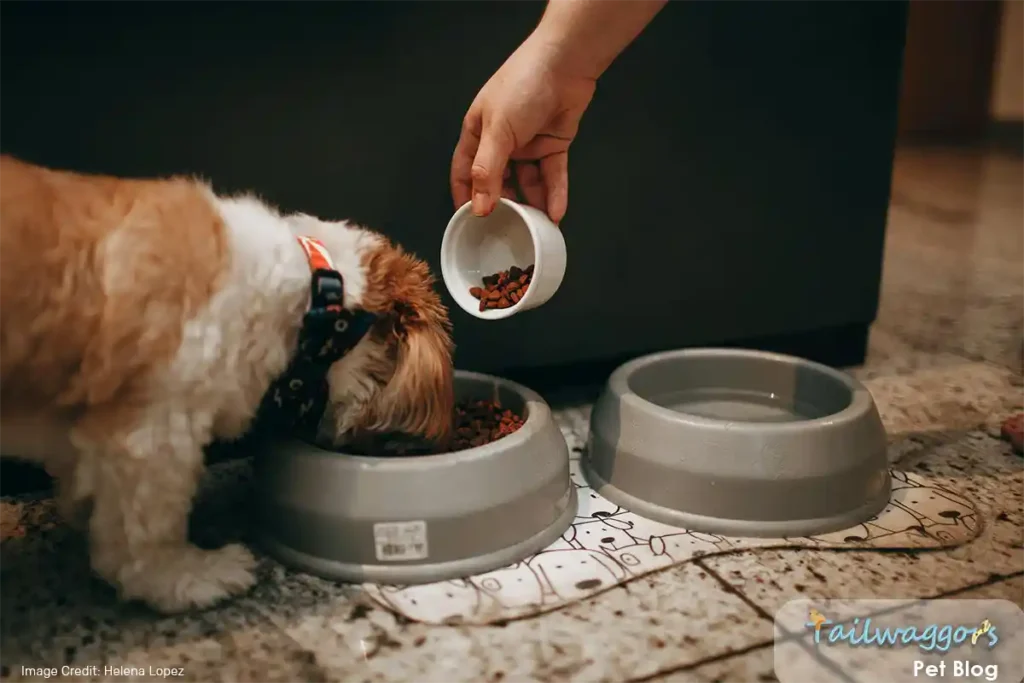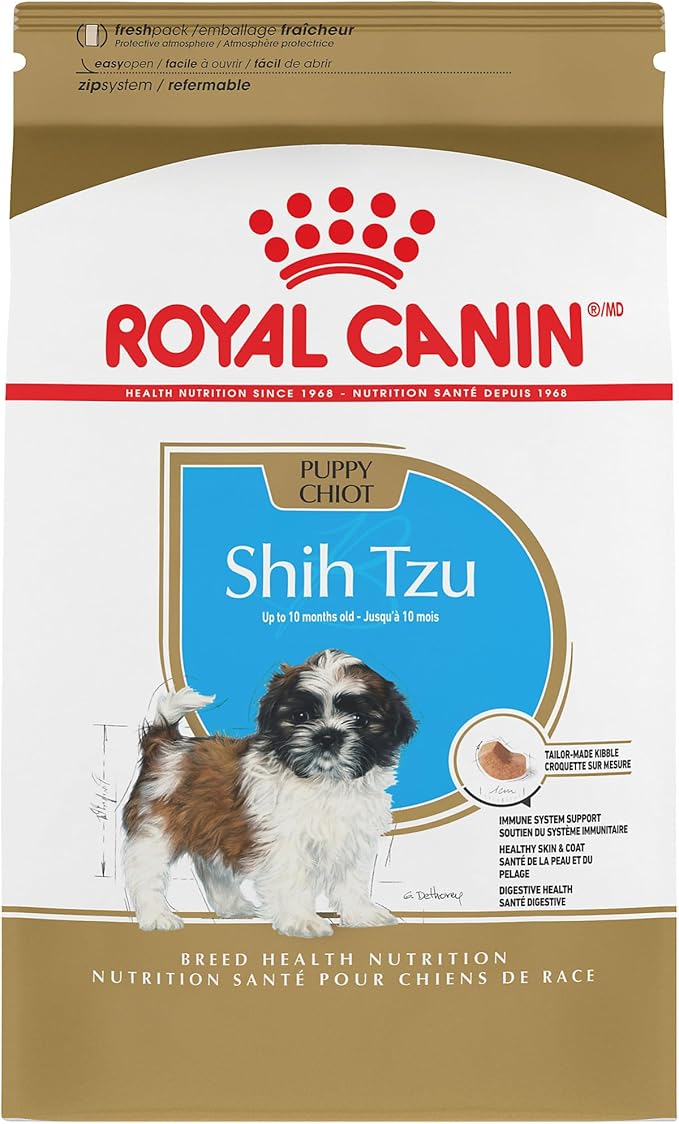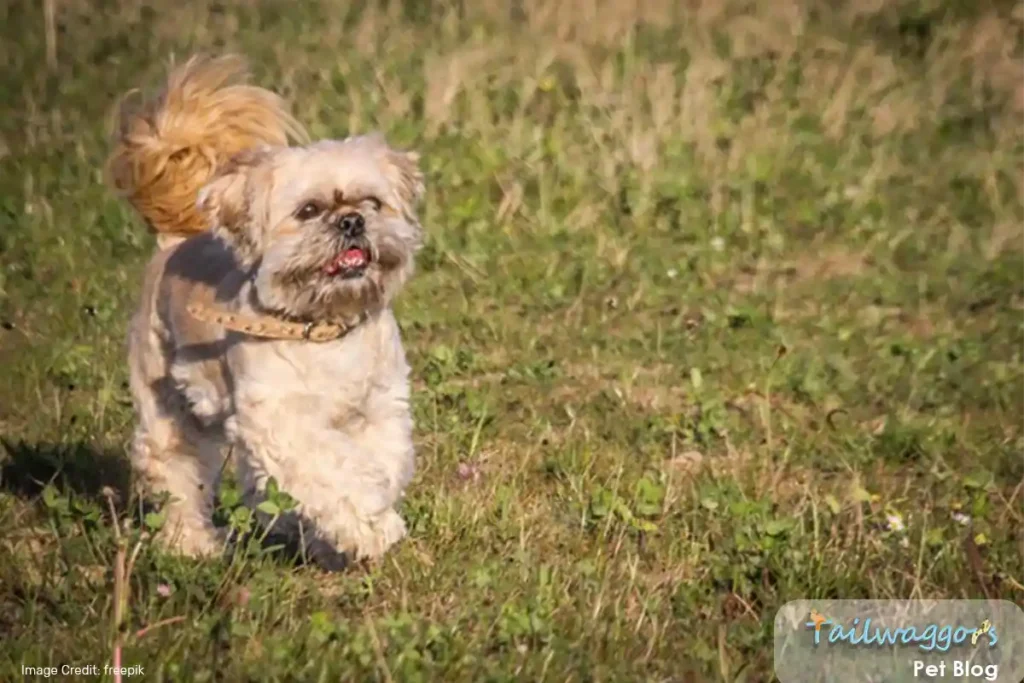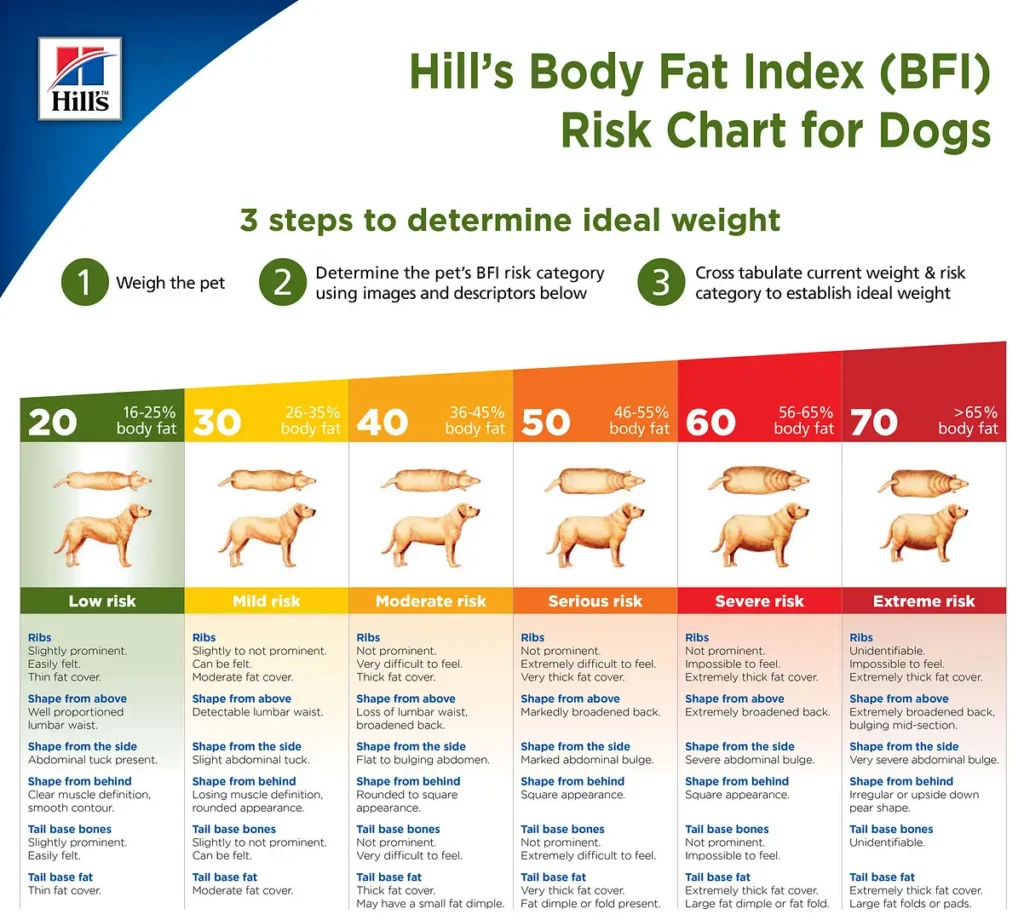Is your Shih Tzu giving you those irresistible, pleading eyes at mealtime? While their charm is unmatched, their diet plays a crucial role in keeping them healthy and active. With rising obesity rates among Shih Tzus, understanding how to balance their nutritional needs can make all the difference. In this guide, we’ll uncover expert-backed tips to keep your furry companion at their healthiest.
Curious about the history and quirks of this delightful breed? Explore everything you need to know in our📚 ➡️ Ultimate Shih Tzu Guide and discover why they’re the perfect blend of royal elegance and lovable mischief.
- • 18-25% protein from quality meat sources
- • 12-15% healthy fats for energy
- • 30-40% digestible carbohydrates
- • 3-5% fiber for digestive health
- • Fresh water available 24/7
Pro Tip: Save our printable feeding chart below to make meal planning effortless!
Understanding Shih Tzu Nutritional Needs
Why Shih Tzus Need Special Diet Attention
We’ve found that Shih Tzus have specific dietary requirements that set them apart from other breeds. Their small size (ideally 9-16 pounds) means every calorie counts! Here’s what makes your furry friend unique:
- Special coat nutritional needs
- Faster metabolism than larger breeds
- Higher risk of dental issues
- Tendency toward weight gain
- Sensitive digestive system
Daily Calorie Calculator for Your Shih Tzu
Use our vet-developed chart to find your pup’s perfect portion size:
| Weight & Activity Level | Daily Calories | Measuring Cup Guide | Best For |
|---|---|---|---|
| 9-12 lbs (Less Active) | 200-275 | ⅓-½ cup per meal | Senior dogs, limited mobility |
| 9-12 lbs (Moderate) | 275-325 | ½-⅔ cup per meal | Most adult Shih Tzus |
| 9-12 lbs (Very Active) | 325-375 | ⅔-¾ cup per meal | Young, energetic dogs |
| 13-16 lbs (Less Active) | 275-350 | ½-⅔ cup per meal | Larger-framed, calmer dogs |
| 13-16 lbs (Moderate) | 350-400 | ⅔-¾ cup per meal | Active larger Shih Tzus |
| 13-16 lbs (Very Active) | 400-450 | ¾-1 cup per meal | Athletic, high-energy dogs |
- • Protein: 18-25% of diet (higher for puppies)
- • Fat: 12-15% of diet
- • Carbohydrates: 30-40% of diet
- • Fiber: 3-5% of diet
- • Vitamin A for coat health
- • Calcium for bone strength
- • Omega-3 fatty acids for skin and coat
- • Glucosamine for joint health
Shih Tzus require carefully balanced diets tailored to their weight, activity levels, and life stage to stay healthy and prevent obesity. Their daily caloric intake ranges from 200 to 450 calories, with portion sizes varying based on weight and activity level.
Essential nutrients like protein (18-25%), fat (12-15%), and carbohydrates (30-40%) support their energy needs, while fiber (3-5%) aids digestion. Key vitamins and minerals—such as Vitamin A for coat health, calcium for strong bones, omega-3 fatty acids for skin and coat, and glucosamine for joint health—ensure overall well-being.
Always consult a veterinarian or refer to AAFCO standards to create the perfect meal plan for your Shih Tzu.

Creating the Ideal Meal Plan
Life Stage Feeding Guide
- 1 Small breed puppy formulas
- 2 3-4 small meals daily
- 3 350-400 calories total
- 1 Small breed adult maintenance
- 2 2-3 meals daily
- 3 275-375 calories total
- 1 Senior small breed formula
- 2 2-3 smaller meals
- 3 200-300 calories total
Creating the ideal meal plan for your Shih Tzu involves tailoring their diet to their life stage and ensuring a consistent feeding schedule.
Puppies (2-12 months) need nutrient-dense small breed puppy formulas, with 3-4 small meals daily, totaling 350-400 calories.
Adults (1-7 years) thrive on small breed adult formulas, consuming 2-3 meals daily with 275-375 calories.
Seniors (8+ years) benefit from senior-specific formulas with 2-3 smaller meals and a total of 200-300 calories.
Daily Feeding Schedule
- 40% of daily calories
- 💧 Fresh water available
- ⏰ No food left out after 20 minutes
- 60% of daily calories
- 💧 Fresh water available
- ⏰ Remove uneaten food after 20 minutes
A daily feeding schedule with 40% of calories in the morning (7-8 AM) and 60% in the evening (5-6 PM), along with fresh water and proper portion management, helps maintain optimal health and energy levels.

Best Food Choices for Your Shih Tzu
- • Small breed-specific formulas
- • Named meat as the first ingredient
- • No artificial preservatives or colors
- • Appropriate kibble size
- • AAFCO nutritional adequacy statement
Top-Rated Commercial Foods (Vet Reviewed 2024)
Here are our top picks based on nutritional value and Shih Tzu-specific needs:

- Breed-specific kibble for Shih Tzus’ unique jaw structure
- Digestive support for less stool odor
- Omega-rich nutrients for healthy skin and coat

- DHA from fish oil supports brain development
- High-quality proteins for muscle growth
- Small kibble size for easy chewing

- Real chicken as first ingredient
- Antioxidant-rich blend
- Glucosamine for joint support

- Probiotics for gut health
- Omega fatty acids for coat health
- Controlled fat levels for weight

- Tailored kibble for flat muzzles
- Enriched with omega fatty acids
- Reduces stool odor

- Gentle chicken and rice recipe
- Supports lean muscle maintenance
- Balanced for small breed energy

- Turkey as lean protein source
- Joint support supplements
- Probiotics for digestion
Special Needs Formulas

- 25% less calories than standard formulas
- High protein (27%) for muscle maintenance
- L-carnitine for fat metabolism
- 70% success rate in weight loss

- Only 360 calories per cup
- Grain-free with prebiotics
- Added glucosamine/chondroitin
- Real turkey as first ingredient

- Limited ingredients formula
- Easily digestible proteins
- Prebiotic fiber blend
- Vitamin E & C blend

- Single protein source
- Supports digestive health
- No corn, wheat, or soy
- Promotes healthy skin and coat
Disclosure: This website contains affiliate links. As an Amazon Associate, we earn from qualifying purchases at no additional cost to you. We only recommend products and services we trust and believe will be valuable to our readers. Thank you for supporting this website!
Selecting the right specialized diet for your Shih Tzu involves more than just picking a brand—it requires tailoring nutrition to their specific needs. For weight management, diets like Hill’s Science Diet Perfect Weight and Wellness CORE Reduced Fat stand out, offering reduced calories, high protein for muscle maintenance, and essential nutrients like L-carnitine to support fat metabolism.
Sensitive stomachs benefit from formulas such as Hill’s Science Diet Sensitive Stomach or Acana Yorkshire Pork for Sensitive Stomachs, which include easily digestible ingredients, prebiotic fiber, and probiotics to promote gut health.
💡 Struggling with tear stains? Check out our Shih Tzu Tear Stains: Complete Prevention & Treatment Guide for tips to keep your pup’s face clean and healthy.
For joint support, options like Blue Buffalo Life Protection Senior and Hill’s Science Diet Healthy Mobility provide glucosamine and chondroitin to maintain joint health, paired with omega-3 fatty acids to reduce inflammation.
Gradual transitions, following a 7-day plan, help prevent digestive upset, while measurable signs like coat quality, stool consistency, and energy levels should be monitored to assess effectiveness. Regular veterinary check-ups ensure the diet meets your Shih Tzu’s needs, and investing in high-quality formulas reduces long-term healthcare costs by preventing chronic conditions.
Not sure when to transition your puppy to adult food? Read more on Transitioning Your Puppy to Adult Dog Food: Vet-Approved Tips.
Pro Tip: Transition to any new diet slowly over 7-10 days to prevent digestive upset.
Homemade Diet Options
- • 1 pound lean protein (turkey/chicken)
- • 2 cups cooked complex carbs (brown rice/sweet potato)
- • 1 cup mixed vegetables (carrots, green beans, peas)
- • 1 tablespoon calcium powder
- • 1 teaspoon fish oil
- • Complete vitamin/mineral supplement
Even though homemade food recipes can be fun and rewarding, it’s crucial to ensure your Shih Tzu gets all the essential nutrients, including minerals, vitamins, and oils, to prevent deficiencies.
Incorporating a dietary specialist is vital when transitioning to a homemade diet to create a balanced and appropriate plan. Instead of experimenting, rely on tested and proven recipes from reputable specialists to avoid nutritional imbalances and costly veterinary bills. Your Shih Tzu’s health and well-being depend on a carefully crafted diet tailored to their unique needs.
Critical Supplements for Special Needs
- • Glucosamine: 20mg per pound body weight
- • Chondroitin: 15mg per pound
- • MSM: 10mg per pound
- • Omega-3: 20mg EPA/DHA per pound
- • Biotin: 0.1mg per pound
- • Vitamin E: 2 IU per pound
- • Probiotics: 1-4 billion CFU daily
- • Digestive enzymes as needed
- • Pumpkin fiber: 1-4 teaspoons daily
Pro Tip: Remember: Always monitor your Shih Tzu’s response to any dietary changes and adjust portions based on weight, activity level, and overall health status. Regular vet check-ups are essential for dogs on special diets..

- Glucosamine and chondroitin for cartilage health
- MSM and ASU for joint mobility
- Protects against cartilage breakdown
- Trusted by veterinarians

- Glucosamine and chondroitin for joint health
- MSM supports cartilage and mobility
- Enhances flexibility and reduces discomfort
- Chewable tablets for easy administration

- Omega-3 for skin and coat health
- Biotin and Vitamin E for shine
- Reduces itching and irritation
- Tasty and easy-to-administer chews

- Omega-3 EPA & DHA for skin and coat health
- Promotes a shiny coat and reduces shedding
- Supports heart, joint, and immune health
- High-quality fish oil from anchovies and sardines
Supplements can play a vital role in addressing your Shih Tzu’s specific health needs, but they must be chosen carefully and tailored to their unique requirements.
For joint health, supplements like Nutramax Dasuquin with MSM and Cosequin Maximum Strength offer beneficial levels of glucosamine, chondroitin, and MSM to support cartilage health, reduce stiffness, and enhance mobility. However, selecting the right product tailored to your Shih Tzu’s specific needs is crucial. Consulting your veterinarian is essential, as the variety of products available is designed to address different conditions. Using the wrong supplement can potentially do more harm than good, making professional guidance vital for your pet’s safety and well-being.
For skin and coat health, Zesty Paws Omega Bites combine omega-3 fatty acids with biotin and Vitamin E to promote a shiny coat and reduce itching, while Nordic Naturals Omega-3 Pet offers high-quality EPA and DHA for coat maintenance and heart health.
Digestive support supplements such as Purina FortiFlora, delivering billions of CFUs of beneficial probiotics, and Nummy Tum Tum Pure Pumpkin, rich in natural fiber, help improve stool quality and regulate digestion. But if there is an underlying condition, these suppliments might not be the answer and then you will know it is time to see the vet for further investigation.
When introducing supplements, monitor your Shih Tzu for visible improvements like smoother movement, reduced scratching, or better stool consistency, and stay alert for any adverse reactions such as vomiting or loose stool.
Always consult your veterinarian before starting a new supplement, as over-supplementation or inappropriate use can cause harm. Choosing tested and trusted products ensures your Shih Tzu receives safe and effective support without unnecessary risks. Regular veterinary check-ups will help fine-tune their dietary regimen and maintain their overall health.

Weight Management & Obesity Prevention
Body Condition Score (BCS) Check

We understand that maintaining a healthy weight for your Shih Tzu can feel challenging at times, but it’s one of the most effective ways to ensure a long, active, and happy life. Like many Shih Tzu owners, you might wonder if your furry companion is at their ideal weight. This is where tools like the Hill’s Body Fat Index (BFI) and the Body Condition Score (BCS) come in handy.
How These Tools Work Together:
The Hill’s BFI provides precise measurements of body fat percentage, offering a scientific foundation for weight management plans. On the other hand, the BCS system uses visual and tactile assessments to evaluate your Shih Tzu’s physique. Together, these methods create a comprehensive picture of your pet’s health.
Mapping the Two Systems:
- BCS 1–3/9: Underweight (BFI < 15%)
Visible ribs, spine, and hip bones with severe abdominal tuck. - BCS 4–5/9: Ideal Weight (BFI 15–25%)
Ribs are palpable but not visible, with a defined waist and abdominal tuck. - BCS 6–9/9: Overweight to Obese (BFI > 25%)
Ribs are difficult to feel, with no visible waist and fat deposits noticeable.
By regularly assessing your Shih Tzu using these methods, you can monitor weight changes effectively and adjust their diet and exercise routines as needed. If you’re ever unsure, we recommend consulting your veterinarian for personalized advice.
🏃 Discover how much exercise your Shih Tzu needs and the best activities to keep them fit in our Shih Tzu Exercise Requirements Guide.
Body Condition Score Guide
- ⚠️ Visible ribs, spine, and hip bones
- ⚠️ Severe abdominal tuck
- ⚠️ Loss of muscle mass
- ✓ Visible waist when viewed from above
- ✓ Ribs can be felt but not prominent
- ✓ Abdominal tuck present
- ! No visible waist
- ! Ribs difficult to feel
- ! Fat deposits visible
- ⚠️ Distended abdomen
- ⚠️ Heavy fat deposits
- ⚠️ No waist definition
Prevention Strategies for Pet Health
- 1 Use a standard measuring cup for accuracy
- 2 Always level off portions to avoid overfeeding
- 3 Avoid guessing; stick to precise measurements
- 1 Keep treats to 10% or less of daily calories
- 2 Opt for low-calorie, nutrient-dense treats
- 3 Break larger treats into smaller pieces
- 1 20–30 minutes of brisk walking daily
- 2 Incorporate fun indoor play sessions
- 3 Engage with mental stimulation activities
Special Dietary Considerations
- 1 Wheat and grains: Can trigger digestive upset or allergies
- 2 Dairy products: Many dogs are lactose intolerant leading to diarrhea
- 3 Artificial preservatives: Can cause allergic reactions
- 4 Certain proteins: Sensitivities to chicken or beef
- 1 Glucosamine supplements: Maintain cartilage health, reduces discomfort
- 2 Omega-3 fatty acids: Reduce inflammation
- 3 Anti-inflammatory ingredients: Natural support
- 1 Limited ingredient diets: Help identify allergens
- 2 Novel protein sources: Less likely to trigger allergies like venison or duck
- 3 Added omega fatty acids: Promote healthy shiny coats, reduces irritation or flakiness
- 1 Appropriate kibble size: Helps clean teeth
- 2 Dental-specific treats: Reduce tartar buildup and freshen breath
- 3 Avoid sticky foods: Prevent plaque buildup and decay
Addressing your Shih Tzu’s special dietary needs ensures their comfort and health. Food sensitivities to grains, dairy, or certain proteins like chicken can be managed with elimination diets or novel protein options like duck. 💡 Struggling with tear stains? Check out our Shih Tzu Tear Stains: Complete Prevention & Treatment Guide for tips to keep your pup’s face clean and healthy.
Joint issues benefit from glucosamine and omega-3s to reduce discomfort and inflammation, while omega fatty acids support healthy skin and coats, minimizing irritation.
For dental health, choose kibble designed to clean teeth and dental-specific treats to reduce tartar.
Always consult a veterinarian for tailored advice and to safely implement dietary changes, ensuring these needs are effectively managed.
Common Diet Mistakes to Avoid
- ❌ Using wrong portion sizes
- ❌ Too many treats
- ❌ Table scraps
- ❌ Sudden changes
- ❌ Mixed feeding methods
- ❌ Inconsistent schedules
- ❌ Human food rewards
- ❌ High-calorie dog treats
- ❌ Frequent treating
Avoiding common diet mistakes is vital for your Shih Tzu’s health. Overfeeding, giving excessive treats, or feeding table scraps can lead to obesity and long-term health issues like diabetes or pancreatitis.
Sudden food changes or inconsistent schedules may cause digestive upset, while high-calorie or human treats undermine proper nutrition. Use measuring cups for portions, choose low-calorie dog treats, and transition foods gradually to maintain a balanced diet and support your Shih Tzu’s overall well-being.

How to switch your Shih Tzu’s food safely: Simple 7-14 Day Guide
Changing your Shih Tzu’s food needs careful planning. Let’s make this transition smooth and safe for your furry friend.
Quick Answer
Most Shih Tzus need 7 days to switch foods. Some need up to 14 days. Follow our vet-approved mixing chart below.
Why Switch Foods Carefully?
Your Shih Tzu’s stomach is sensitive. Quick food changes can upset their digestion leading to diarrhea. Smart transitions keep your Shih Tzu healthy and happy.
- → Mix thoroughly
- → Keep portions normal
- → Equal portions
- → Monitor digestion
- → Mostly new food
- → Watch for changes
- → Complete transition
- → Monitor success
Health Watch Guide for Your Shih Tzu
- ! Runny stools
- ! Different stool color
- ! More or less pooping
- ! Mucus in poop
- ! Throwing up
- ! Not eating
- ! Low energy
- ! Extra tired
- ! Pain after meals
- ✓ Measure food exactly
- ✓ Feed at set times
- ✓ Write down changes
- ✓ Skip new treats
- ✓ Take it slow
- ✓ Clean bowls daily
- • Older dogs might need 14 days
- • Sick dogs need vet guidance
- • Puppies may switch faster
- • Active dogs might eat more
- ! Problems lasting over 24 hours
- ! Multiple bad signs
- ! Clear distress
- ! Big behavior changes
- ! Bad stomach issues
Monitoring your Shih Tzu’s health is vital to catching early signs of issues and ensuring their well-being. Digestive warning signs like runny stools, changes in stool color, vomiting, or mucus in the stool should be taken seriously. Behavior changes, such as lethargy, lack of appetite, or visible discomfort after meals, can also indicate underlying problems.
For success, measure food accurately, maintain a consistent feeding schedule, and document any changes. Always introduce new treats or dietary adjustments slowly. If symptoms persist for over 24 hours, worsen, or involve clear distress, consult your veterinarian immediately to address potential health concerns and prevent complications.

Seasonal Diet Guide
Adjust your Shih Tzu’s diet with the seasons for optimal health and comfort
Summer Adjustments
🕒 Feeding Schedule
- Morning meal: 40% (before 8 AM)
- Evening meal: 60% (after 6 PM)
- Multiple water stations
- Reduced treat portions
🧊 Cooling Treats
- Frozen yogurt cubes
- Watermelon balls (no seeds)
- Chilled cucumber slices
- Frozen broth cubes
- Monitor water intake
- Watch for dehydration
- Keep food fresh
Winter Adjustments
🍽️ Portion Adjustments
- Increase calories by 10-15%
- Equal morning/evening portions
- Add warm water if needed
- Indoor exercise snacks
🌡️ Warming Options
- Room temperature meals
- Warmed wet food
- Bone broth additions
- Mental stimulation treats
- Never serve hot food
- Monitor indoor activity
- Adjust to exercise levels
Adjusting your Shih Tzu’s diet with the seasons ensures their health and comfort year-round. In summer, focus on hydration with multiple water stations and cooling treats like frozen yogurt or watermelon balls, while feeding earlier and later to avoid the heat.
In winter, increase calorie intake by 10-15% to match energy needs, and consider warming meals with bone broth or room-temperature food to keep them cozy. Always monitor their water intake, activity levels, and portion sizes to align with seasonal demands, ensuring your Shih Tzu stays happy and healthy regardless of the weather.
❄️ Need winter-friendly activity ideas? Visit our Shih Tzu Exercise Requirements Guide to keep your pup active even in the cold months.
Emergency Diet Information
- ! Sudden Weight Changes: If your Shih Tzu gains or loses more than 10% of their body weight within a month
- ! Food Refusal: Not eating or showing interest in food for more than 24 hours, even their favorite treats
- ! Excessive Thirst: Drinking much more water than usual or unable to quench their thirst despite frequent drinking
- ! Digestive Issues: Multiple episodes of vomiting or diarrhea within 24 hours, or if stools contain blood
- ! Allergic Reactions: Excessive scratching, facial swelling, hives, or difficulty breathing after eating
- ✓ Food Journal: Keep track of what and when your pet ate in the last 48 hours
- ✓ Recent Photos: Pictures showing any physical changes or symptoms
- ✓ Food Packaging: Keep any packaging from recent foods or treats
- ✓ Symptom Timeline: Note when you first noticed any changes
- 1 Stop New Foods: Return to their last known safe food immediately
- 2 Fresh Water: Ensure clean, fresh water is always available
- 3 Quiet Space: Provide a calm, comfortable area away from other pets
- 4 Monitor Closely: Watch for any worsening symptoms or new concerns
Diet-related emergencies in Shih Tzus require quick action and careful observation. Seek immediate veterinary care if your dog experiences sudden weight changes, refuses food for over 24 hours, shows excessive thirst, has repeated vomiting or diarrhea, or displays allergic reactions like swelling or difficulty breathing.
Keep a food journal, note symptoms with photos and timelines, and bring food packaging to the vet.
For immediate care, stop new foods, offer fresh water, and create a calm space. For severe symptoms like breathing issues or bloody stools, contact your vet or an emergency clinic without delay. Prompt action can save lives.
Daily Feeding Checklist
- ☐ Measure breakfast portion precisely
- ☐ Refresh water bowl
- ☐ Note morning appetite level
- ☐ Track treat consumption
- ☐ Monitor energy levels
- ☐ Watch for dietary reactions
- ☐ Measure dinner portion precisely
- ☐ Clean food and water bowls
- ☐ Log daily food intake
- ☐ Record weight (same time each week)
- ☐ Review feeding log notes
- ☐ Adjust portions if needed
A structured feeding routine is key to maintaining your Shih Tzu’s health and preventing potential issues. In the morning, measure breakfast portions accurately using a food scale for precision, refresh the water bowl, and note appetite levels to spot early signs of dietary issues.
Throughout the day, track treat consumption, monitor energy levels, and watch for changes like unusual lethargy or hyperactivity, which can indicate imbalances.
In the evening, repeat precise portioning for dinner, clean bowls thoroughly to prevent bacterial growth, and log daily food intake, noting any irregularities.
Weekly, weigh your Shih Tzu at the same time and review their feeding log for trends, adjusting portions as needed—for example, reducing food if weight increases or increasing if energy drops unexpectedly.
Consistency and careful observation help prevent obesity, digestive issues, and other diet-related problems, ensuring your Shih Tzu’s long-term health and vitality.
Pro Tip: Keep a feeding diary for two weeks when making any dietary changes. Track:
- Energy levels throughout the day
- Stool quality and frequency
- Coat condition and shine
- Appetite and eating behavior
This helps us fine-tune recommendations for your specific pup.
🐾 Love Shih Tzus as much as we do? 🐶
Share this guide with your fellow dog lovers and let them discover everything they need to know about keeping their Shih Tzu happy and healthy.
💌
Expert Q&A: Shih Tzu Diet & Nutrition
Dr. Esther Knoetze (BSc)(BVSc), answers your questions about Shih Tzu nutrition and diet management.
Mealtime Challenges
Start with our proven 3-step method:
- Feed at consistent times daily
- Remove food after 20 minutes
- Never feed from the table
Consistency is key – begging is a learned behavior that can be modified with proper training. Pair consistent feeding routines with positive reinforcement, like praising or rewarding calm behavior, to reinforce desirable habits and discourage begging over time.
First, let’s rule out dental issues – many ‘picky’ dogs actually have sensitive teeth. Try these proven solutions:
- Serve food at room temperature
- Maintain strict meal times
- Remove uneaten food after 20 minutes
- Avoid frequent food changes
Remember: While occasional picky eating is common, prolonged refusal to eat may signal dental pain, digestive issues, or other health problems. Consult your veterinarian if the behavior persists or worsens.
Fast eating can lead to digestive issues, choking or, in rare cases, bloating. Supervise meals, and consider slow-feeder bowls or puzzle toys to encourage slower, safer eating. Here are effective solutions:
- Use slow-feeder bowls
- Try food puzzle toys
- Implement scatter feeding
- Split into multiple small meals
Weight Management
Aim for a loss of 1-2% of body weight per week:
- 16lb dog: target 0.16-0.32lb weekly loss
- Track progress with weekly weigh-ins
- Adjust portions monthly
- Include appropriate exercise
Work with your veterinarian to monitor progress through regular weigh-ins and ensure the weight loss is healthy. Sudden or drastic weight loss can be harmful and should be avoided.
Yes, but start gently:
- 10-15 minute walks twice daily
- Swimming (with proper support)
- Indoor obstacle courses
- Mental stimulation activities
Start with low-impact activities like short walks or swimming, gradually increasing as tolerated. Incorporate joint-friendly supplements like glucosamine to support mobility and reduce discomfort.
Special Dietary Needs
Focus on low-glycemic options:
- Fresh green beans
- Small pieces of lean meat
- Sugar-free jerky (watch sodium)
- Freeze-dried liver (in moderation)
Stick to treats like green beans or lean meat in small portions to avoid blood sugar spikes. Always verify treat options with your veterinarian.
This requires management:
- Feed in separate rooms
- Use raised bowls for larger dogs
- Consider microchip-activated bowls
- Supervise all mealtimes
Along with separate feeding spaces, train your Shih Tzu to respect boundaries using simple commands like “leave it” or “stay.”
Seasonal Adjustments
Make these seasonal adjustments:
- Increase water content in food
- Feed smaller, more frequent meals
- Adjust portions based on activity
- Consider frozen treats for enrichment
Ensure your Shih Tzu has access to fresh water throughout the day, as their flat faces make them more prone to overheating. Signs of dehydration include dry gums, sunken eyes, and lethargy.
Show-quality coats need:
- 25-30% protein from quality sources
- Omega-3 fatty acids (EPA/DHA)
- Biotin supplementation
- Zinc and vitamin E
Age & Health Transitions
Look for these signs around age 7-8:
- Slowing metabolism
- Less activity
- Joint stiffness
- Dental changes
Consider these dietary adjustments:
- Lower calorie density (about 350-375 kcal/cup)
- Higher fiber content for digestion
- Added glucosamine for joint health
- Easier-to-digest protein sources
Remember, age alone isn’t the deciding factor – consider overall health and activity level. Always consult with your vet before making the switch.Gradually transition to senior food over 10-14 days to reduce the risk of digestive upset. Always consult your veterinarian to ensure the new food meets their specific health needs.
Follow this 7-day transition plan:
- Days 1-2: 75% old food, 25% new food
- Days 3-4: 50% old food, 50% new food
- Days 5-6: 25% old food, 75% new food
- Day 7: 100% new food
Watch for any digestive issues during the transition. For dogs with sensitive stomachs, extend the transition to 10-14 days, gradually increasing the proportion of new food. Monitor for signs of digestive upset like diarrhea or vomiting.
Consider these winter adjustments:
- Slightly increased calories if outdoor activity continues
- Warm meals are acceptable
- Adjust portions based on indoor activity levels
- Maintain adequate hydration despite cooler weather



















